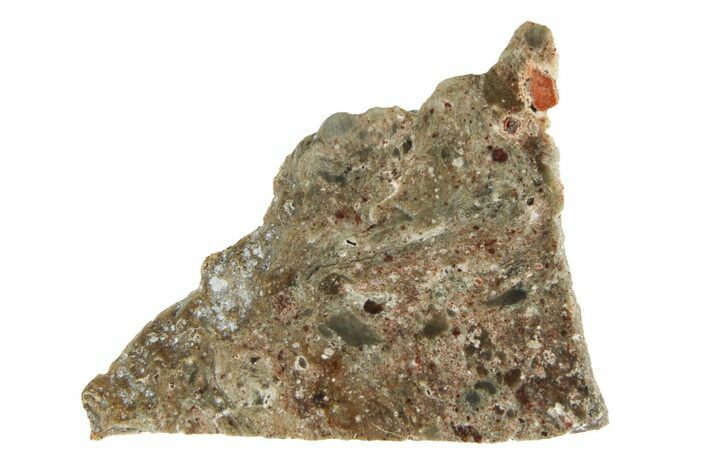This Specimen has been sold.
.55" Polished Lunar Meteorite Slice (0.24 g) - Tisserlitine 001
This is a .55" wide (0.24 grams) slice of the lunar meteorite, Tisserlitine 001. It has been nicely cut into a thin slice and polished to a glossy finish on one side.
This lunar feldspathic breccia was found near the Mali-Algeria border starting from December 2019. Over the next few months, a total known mass of about 47.7 kilograms was recovered and sold by Algerian dealers. The largest single mass of that group weighs about 40 kilograms alone.
Tisserlitine 001 is characterized by "knobby" exteriors, and are often flat and slab-like in appearance. They lack fusion crust, likely eroded by conditions in the Sahara. The interiors contain a variety of whitish to dark gray clasts like most lunar breccias, but Tisserlitine 001 displays more brown to pinkish hues and occasional metal grains.
Tisserlitine 001 may be paired with another meteorite found in the same area aroudn the same time: NWA 13621. Both meteorites have notably flat shapes, and display the same knobby exteriors and pinkish to brownish interiors.
Tisserlitine 001 is characterized by "knobby" exteriors, and are often flat and slab-like in appearance. They lack fusion crust, likely eroded by conditions in the Sahara. The interiors contain a variety of whitish to dark gray clasts like most lunar breccias, but Tisserlitine 001 displays more brown to pinkish hues and occasional metal grains.
Tisserlitine 001 may be paired with another meteorite found in the same area aroudn the same time: NWA 13621. Both meteorites have notably flat shapes, and display the same knobby exteriors and pinkish to brownish interiors.
Moon Rocks... On Earth...
Think the only moon rocks on Earth are samples brought back from Apollo missions? Think again!
Lunar meteorites are type of achondrite meteorites that were formed like other stony (chondrite) meteorites, but they were ejected into space by meteorites and other celestial bodies hitting the moon. Almost all lunar meteorites are brecciated amalgamations of feldspathic and basaltic rocks commonly found on the Moon's surface.
Lunar meteorites are pretty rare to find on Earth: the vast majority of meteorites are from the asteroid belt, and less than 1 percent of classified meteorites are lunar in origin. The total mass of all known lunar meteorites is probably less than 1,000 kilograms. Owning a piece of the moon is a pretty rare accomplishment!
One reason they are so rare is because lunar meteorites superficially look just like earth rocks. Even a true meteorite expert would not recognize a lunar meteor laying on the ground among earthly stones. Lunar meteorites have only been recognized in places naturally devoid of rocks, like sandy deserts and ice sheets. In fact, there has never been a lunar meteorite classified from North America, South America or Europe. Most are found in the Sahara Desert (Northwest Africa), Antarctica, or Oman. All Antarctic meteorites are governmental property so they cannot be privately attained.
Think the only moon rocks on Earth are samples brought back from Apollo missions? Think again!
Lunar meteorites are type of achondrite meteorites that were formed like other stony (chondrite) meteorites, but they were ejected into space by meteorites and other celestial bodies hitting the moon. Almost all lunar meteorites are brecciated amalgamations of feldspathic and basaltic rocks commonly found on the Moon's surface.
Lunar meteorites are pretty rare to find on Earth: the vast majority of meteorites are from the asteroid belt, and less than 1 percent of classified meteorites are lunar in origin. The total mass of all known lunar meteorites is probably less than 1,000 kilograms. Owning a piece of the moon is a pretty rare accomplishment!
One reason they are so rare is because lunar meteorites superficially look just like earth rocks. Even a true meteorite expert would not recognize a lunar meteor laying on the ground among earthly stones. Lunar meteorites have only been recognized in places naturally devoid of rocks, like sandy deserts and ice sheets. In fact, there has never been a lunar meteorite classified from North America, South America or Europe. Most are found in the Sahara Desert (Northwest Africa), Antarctica, or Oman. All Antarctic meteorites are governmental property so they cannot be privately attained.
TYPE
Lunar (Feldspathic Breccia)
AGE
LOCATION
Kidal Region, Mali
SIZE
.55 x .32", .045" thick, Weight: 0.24 grams
CATEGORY
ITEM
#280684
 Reviews
Reviews












